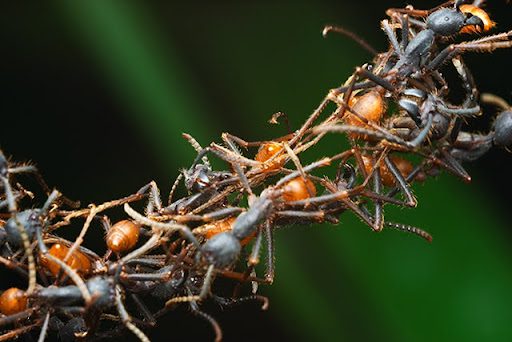Last Updated: 08/05/2024.
Fire ants in Michigan are a group that belong to the subfamily Formicinae, tribe Solenopsidini. They are native to South America and were accidentally introduced to the United States in the early 20th century. Today, fire ants are one of the most common and widespread ant pests in the United States, and they have been found in all but a few states, including Michigan.
Fire ants are not only a nuisance, but they can also be a serious threat to human health and the environment. Their bites can be painful and cause allergic reactions in some people. Fire ants can also damage crops and property, and they can even spread diseases. In this article, we will explore the secrets of fire ants in Michigan, their distribution and habitat, different species and characteristics, their impact on the ecosystem and agriculture, risks and hazards of their bites, prevention and control measures, and natural predators and biological control methods.
Please join Let’s save Michigan to learn more through this article.
Distribution and Habitat of Fire Ants in Michigan
Fire ants are found in a variety of habitats in Michigan, including forests, grasslands, and urban areas. They are most commonly found in areas with warm, moist climates, and they are typically found in sunny locations. Fire ants build their nests in the ground, and they can be found in a variety of soil types, including sand, loam, and clay.
In Michigan, fire ants have been reported in several counties, including Kent, Oakland, Wayne, and Washtenaw. However, their distribution is not as widespread as in other states due to the colder climate. Fire ants prefer temperatures between 70-95 degrees Fahrenheit, and they cannot survive in temperatures below 10 degrees Fahrenheit. This limits their ability to establish large colonies in Michigan, but they can still pose a threat to the local ecosystem and agriculture.
Fire Ant Species and Their Characteristics

There are three main species of fire ants that are found in Michigan:
Red Imported Fire Ant (Solenopsis invicta)
This is the most common species of fire ant in Michigan. Red imported fire ants are small, reddish-brown ants that are about 1/16 to 1/8 of an inch long. They have a stinger at the end of their abdomen, which they use to inject venom into their prey or when defending their colony. These ants are known for their aggressive behavior and can quickly swarm and attack when their nest is disturbed.
Black Imported Fire Ant (Solenopsis richteri)
This species is very similar to the red imported fire ant, but it has a darker coloration. They are slightly larger than the red imported fire ants, measuring between 1/8 to 3/16 of an inch long. Black imported fire ants also have a painful sting and can cause allergic reactions in some people.
Southern Fire Ant (Solenopsis xyloni)
This species is less common in Michigan, but it has been reported in some areas. They are smaller than the other two species, measuring only 1/16 of an inch long. Southern fire ants are light brown in color and have a less painful sting compared to the other two species.
All three species of fire ants have similar characteristics and behaviors. They are omnivorous, feeding on both plant and animal matter. They are also highly territorial and will aggressively defend their nests from any perceived threats.
Impact of Fire Ants on Michigan’s Ecosystem and Agriculture
Fire ants can have a significant impact on Michigan’s ecosystem and agriculture. As mentioned earlier, they are aggressive predators that can harm native insect populations. This can disrupt the natural balance of the ecosystem and affect the survival of other species. In agriculture, fire ants can damage crops by feeding on seeds, seedlings, and fruits.
They can also build their nests in agricultural fields, making it difficult for farmers to harvest their crops. In some cases, fire ants have been known to cause significant economic losses in the agriculture industry.
Risks and Hazards of Fire Ant Bites
One of the biggest concerns with fire ants is their painful sting. When a fire ant bites, it injects venom into the skin, causing a burning sensation and intense pain. The area around the bite may also become swollen, red, and itchy. In some cases, people can have severe allergic reactions to fire ant bites, which can be life-threatening.
Fire ant bites are not only a risk to humans but also to pets and livestock. Animals can suffer from multiple bites, which can lead to anaphylactic shock or even death. Livestock can also experience reduced milk production and weight loss due to fire ant infestations.
Prevention and Control Measures for Fire Ant Infestations

Preventing and controlling fire ant infestations is crucial to protect human health, the environment, and agriculture. Here are some measures that can help prevent and control fire ants in Michigan:
- Avoid disturbing fire ant nests: If you come across a fire ant nest, do not disturb it. These ants are highly territorial and will aggressively defend their colony if they feel threatened.
- Keep your yard clean and tidy: Fire ants are attracted to food sources, so keeping your yard free of debris, food scraps, and pet food can help reduce their presence.
- Seal cracks and openings: Fire ants can enter buildings through small cracks and openings. Seal these entry points to prevent them from coming inside.
- Use baits and insecticides: There are several baits and insecticides available for fire ant control. However, it is essential to follow the instructions carefully and use them safely.
- Seek professional help: If you have a severe fire ant infestation, it is best to seek professional help. Pest control companies have the expertise and equipment to effectively eliminate fire ant colonies.
Natural Predators and Biological Control of Fire Ants
Apart from chemical control methods, there are also natural predators and biological control measures that can help manage fire ant populations. These include:
- Ant-decapitating flies: These parasitic flies lay their eggs on fire ants, and when the larvae hatch, they feed on the ant’s head, eventually killing it.
- Pseudacteon phorid flies: These flies attack fire ants by laying eggs inside their bodies. The larvae then consume the ant from the inside, causing its death.
- Other ants: Some species of ants, such as the thief ant and the little black ant, are known to prey on fire ants and can help keep their populations in check.
Conclusion
In conclusion, fire ants are a common pest in Michigan that can cause harm to humans, the environment, and agriculture. It is essential to take preventive measures and seek professional help if you have fire ants in Michigan infestation.
Letssavemichigan understands that worrying issue and has outlined an overview of important knowledge about fire ants in Michigan to help you take better preventive measures, and protect yourself, the community, and the ecosystem from threats from fire ants.






